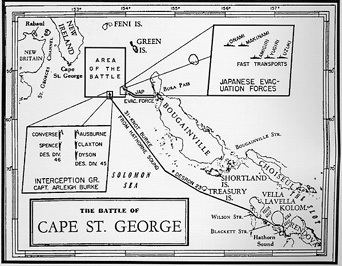5 destroyers 5 destroyers Result U.S. victory | Dates 25 Nov 1943 – 26 Nov 1943 | |
 | ||
None 3 destroyers sunk,1 destroyer damaged,647 killed Similar Battle off Horaniu, Battle of Empress Augusta, Naval Battle of Vella Lav, Battle of Vella Gulf, Battle of Kula Gulf | ||
Battle of cape st george
The Battle of Cape St. George was a naval battle of the Pacific campaign of World War II fought on 25 November 1943, between Cape St. George, New Ireland, and Buka Island (now part of the North Solomons Province in Papua New Guinea). It was the last engagement of surface ships in the Solomon Islands campaign.
Contents
Background
Americans had landed troops on Bougainville on 1 November 1943. This posed a threat to the Japanese base on Buka Island to the north, and 900 Japanese Army troops were embarked on the destroyers Amagiri, Yūgiri and Uzuki under the command of Captain Katsumori Yamashiro and were sent to reinforce the garrison, escorted by the destroyers Ōnami and Makinami under the command of Captain Kiyoto Kagawa. The United States Navy learned of the convoy and sent Captain Arleigh Burke's Destroyer Squadron 23 composed of Destroyer Division 45 (Charles Ausburne, Claxton, and Dyson) under Burke's direct command and Destroyer Division 46 (Converse and Spence) under the command of Commander B Austin to intercept it.
Battle
The Japanese battle plan divided their force into two columns, with the three transport destroyers trailing the two escort destroyers by approximately 10,000 meters: far enough apart to make simultaneous attacks on both columns unlikely but close enough that each could come to the other's assistance or flee if necessary. The American battle plan also divided their force into two columns using tactics devised by Burke and first employed successfully by Commander Frederick Moosbruger at the Battle of Vella Gulf the previous August. One column would make a torpedo attack while the other took up a supporting position ready to open gunfire as soon as the first column's torpedo attack struck home.
The Japanese destroyers landed the 900 troops and supplies and embarked an equivalent number of Navy aviation personnel being withdrawn. The Japanese force was returning to Rabaul when Kagawa's two screening destroyers were spotted on radar by USS Dyson at about 01:40; poor visibility prevented the Japanese from spotting the American ships in turn. Burke elected to use his own division for the torpedo attack. Superior radar allowed the American ships to approach within 5,500 yards and launch their torpedoes at about 01:55 before the Japanese sighted them. Onami was hit by several torpedoes and sank immediately. Makinami was hit by one torpedo and disabled.
Burke's force gained radar contact with the rest of the Japanese force at 13,000 yards soon after launching their torpedoes and turned to pursue; Yamashiro's three transport destroyers fled North under pursuit by Burke's division while Converse's division finished off the disabled Makinami with torpedoes and gunfire. Burke's three destroyers steadily gained on the three heavily laden Japanese destroyers so they split up at 02:56 and fled in different directions. Burke chose to pursue Yuguri with his entire force and sank her at about 03:28 after a fierce engagement, though USS Dyson continued firing at the other two for as long as her guns would bear. Uzuki was hit by one dud shell and escaped without significant damage. Amagiri escaped untouched
Aftermath
The battle marked the end of the Tokyo Express and the end of Japanese resistance in the Solomon Islands, and the success of Allied efforts to achieve superiority in night combat using radar. With the exception of Operation Hailstone around Truk in early 1944, there were no more surface engagements in the Pacific War until the Mariana and Palau Islands campaign began with the invasion of Saipan in June 1944.
Namesake
The U.S. Navy Ticonderoga-class guided-missile cruiser USS Cape St. George (CG-71), in commission since 1993, was named for this battle.
